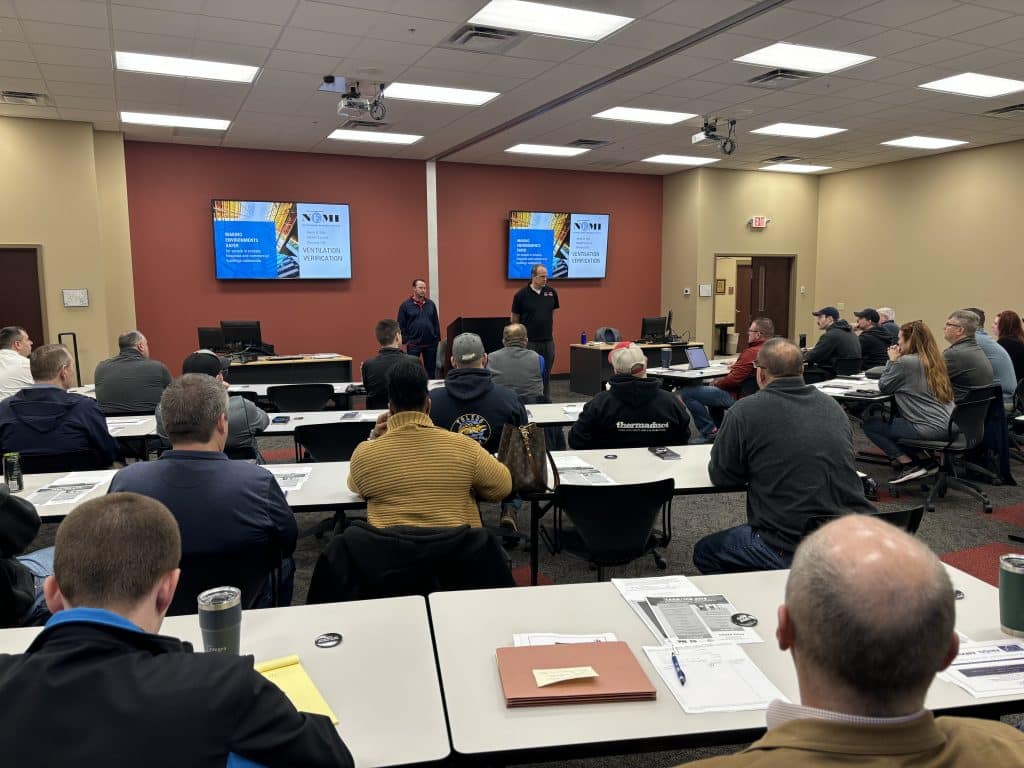
Preparing for the future of work isn’t new to SMART Local 33 in Cleveland. During the recession, contractors learned how HVAC Fire Life Safety skills could keep workers on the job while providing valuable services to commercial buildings in the area. With the pandemic in the rearview mirror, Local 33 hosted the National Energy Management Institute (NEMI) during a Ventilation Verification/Indoor Air Quality Awareness course on March 15.
The idea was to let contractors know they already have the skills to test the health of buildings in their area. It’s all about perspective.
With all the federal funding available — not just for schools, but for commercial and residential buildings too — Corey Beaubien, president and business manager of Local 33, and Lisa Davis, NEMI administrator, thought it was an opportune time to show the local’s sheet metal contractors that the work scope for Ventilation Verification/Indoor Air Quality isn’t just for TAB contractors.
“It’s a great way for people to continue their connection with their customers after the building is built by maintaining their contact through ongoing Ventilation Verification/Indoor Air Quality audits and monitoring,” Davis said. “In this way, the building owners not only get continuing increased indoor air quality throughout the life of the building, but the contractors are there to provide other services as well when other needs come up.”
NEMI, ITI and SMART contributed to the one-day course, which presented the scope of Ventilation Verification/Indoor Air Quality, challenged attendees to a hands-on portion and educated them on grant and funding opportunities as well as training and certification resources.
In addition to finding ways to keep workers on the job — just as educating contractors on fire life safety did in the 2010s — Ventilation Verification/Indoor Air Quality also opens doors for state and federal grants that fund renovations of a building’s HVAC system, Beaubien said.
“The class has generated interest. They had a better overall understanding about how it works, and that’s the beginning,” he added. “The class was meant to get the ball rolling.”
The skills needed to complete Ventilation Verification/Indoor Air Quality are typically taught during apprenticeship, and it doesn’t take TAB expertise to complete, which came as a surprise to some in attendance. Like fire life safety, this course showed contractors a different perspective — it’s a chance to get more work, but it’s also an opportunity to teach building owners of assisted living facilities, government and commercial buildings how to keep their buildings healthy and safe for their occupants, Beaubien said.
“Fire life safety was a big success. It was an idea to generate work opportunities but also to save lives,” he added. “This is another opportunity to educate contractors and the end users about what is going on above their ceilings.”
Davis added: “We are looking forward to assisting contractors and Local 33 with implementation of Ventilation Verification/Indoor Air Quality in their area, whether that looks like assisting them in helping their customers apply for grants or going after code or specification changes that would include a skilled, trained, certified workforce.”
Related News
- NEMIC appoints Lisa Davis as administrator
- Dangerous air quality underscores the importance of high-quality HVAC systems
- Local IAQ legislation promises new opportunities
- ITI ramps up Ventilation Verification for IAQ curriculum
- NEMI, AEA partner on theater ventilation protocols
- Improved IAQ Standards Announced by White House
- Raising standards for indoor air quality — the SMART way